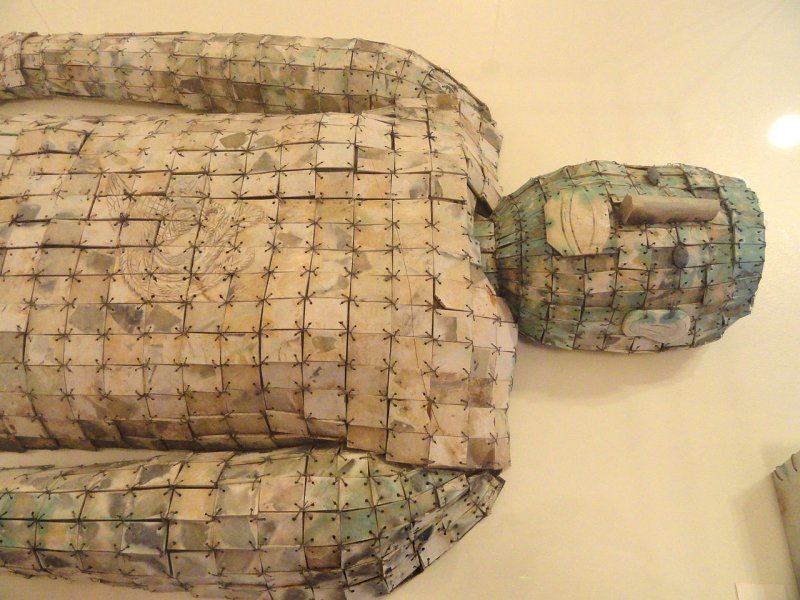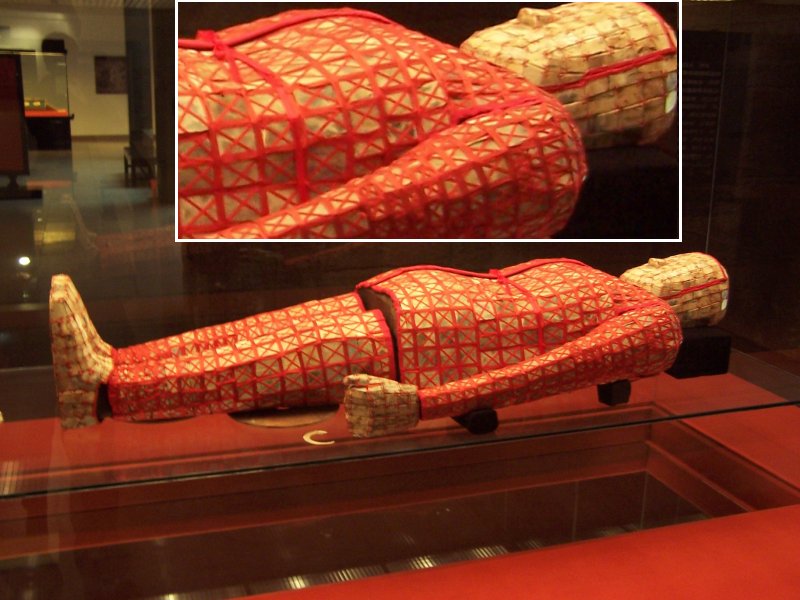Precious Ancient Chinese Immortality Suits Made Of Jade
A. Sutherland - AncientPages.com - Jade suits were first documented in literature around AD 320, although there is archaeological proof of their existence that dates back thousands of years.
Detail of a jade burial suit with replaced copper wire in the George Walter Vincent Smith Art Museum in Springfield, Massachusetts. Image credit: Daderot - CC0
The Chinese people have long considered jade to be foremost among the most valuable treasures that Nature offered humanity.
During the Neolithic Age, stoneworking gradually gave rise to the production of jade articles. At first, jade was used to make ornaments, and later, for making ritual objects used in sacrificial ceremonies.
Ancient texts dated to the Han Dynasty (206 BC - 220 CE) say that members of the imperial family were buried in jade burial suits.
According to the Book of Later Ha, an ancient document, during Han era, jade burial outfits for the Chinesee emperors were sewed by gold threads, while other royal family members had the jade clothes put together with silver or copper threads.
Detail of the hand section of the jade burial suit of Liu Sui, Prince of Liang, of Western Han. Image credit: Zcm11 - CC BY-SA 3.0
The type of threads used for the preparation of the jade burial suit, depended on the social status of the buried person. People believed jade possessed magical properties to protect the body from decay and ward off evil spirits. Attempts to preserve the body reflect the belief that the earthly aspect of the soul continues to dwell in the body after death.
First, jade materials transported from far-away places were processed into thousands of small jade pieces of specific shapes and sizes.
Secondly, each jade piece was polished and drilled, with the shapes and sizes of the holes undergoing particular scrutiny; thirdly, a lot of specially made gold, silver, or copper threads were used to join the jade pieces.
The jade burial suits of emperors used gold thread; princes, princesses, dukes, and marquises, silver thread; sons or daughters of those given silver thread, copper thread; and lesser aristocrats, silk thread. All others were forbidden to be buried in jade burial suits.
Making a jade burial suit was problematic because its hand-making process was complicated and sophisticated.
Jade burial suit at the Museum of the Mausoleum of the Nanyue King, in Guangzhou. Image credit: Pubuhan - CC BY-SA 2.5
The most beautiful suits are today preserved in Xuzhou, a city little known in the Western world, but during the early Han Dynasty, Xuzhou was one of the most important regions of China.
Liu Sheng's jade suit was made of 2498 pieces of jade, sewn together with 1.1 kilograms of gold thread (Dou Wan's was smaller). Each jade suit had twelve sections: face, head, front, and back of the tunic, arms, gloves, leggings, and feet.
The golden thread and jade clothes of Liu Sui from the tomb of Xishan No. 1 in the Western HanDynasty. The jade clothes were scattered when they were unearthed. After restoration, the length of the jade clothes was 1.76 meters. Image credit: Zcm11 - CC BY-SA 3.0
Experts estimate that a suit such as Liu Sheng's would have taken ten years to fashion. Along with the jade suits, Liu Sheng and Dou Wan each had a gilt bronze headrest inlaid with jade and held jade crescents in their hands.
After the Han Dynasty, the jade burial suit practice was forbidden in 222 and gradually disappeared.
Written by – A. Sutherland - AncientPages.com Senior Staff Writer
Updated on September 27, 2022
Copyright © AncientPages.com All rights reserved. This material may not be published, broadcast, rewritten or redistributed in whole or part without the express written permission of AncientPages.com
Expand for referencesReferences:
Kaleidoscope Cultural China
S-K. Psarras, Han Material Culture
[/expandMore From Ancient Pages
-
 Idol Of Pachacamac Inca God Reveals Its Colors
Archaeology | Jan 21, 2020
Idol Of Pachacamac Inca God Reveals Its Colors
Archaeology | Jan 21, 2020 -
 Cuchulainn: Irish Mythical Hero And His Cruel Magical Spear Gae Bolg
Celtic Mythology | Jun 6, 2017
Cuchulainn: Irish Mythical Hero And His Cruel Magical Spear Gae Bolg
Celtic Mythology | Jun 6, 2017 -
 Early Humans May Have First Walked Upright In The Trees 7 Million Years Ago
Human Beginnings | Dec 17, 2022
Early Humans May Have First Walked Upright In The Trees 7 Million Years Ago
Human Beginnings | Dec 17, 2022 -
 On This Day In History: Richard The Lionheart Arrives To The Holy Land – On June 8, 1191
News | Jun 8, 2016
On This Day In History: Richard The Lionheart Arrives To The Holy Land – On June 8, 1191
News | Jun 8, 2016 -
 Ancient Venetian Merchants Were Always Prepared For The Worst
Featured Stories | Jul 12, 2024
Ancient Venetian Merchants Were Always Prepared For The Worst
Featured Stories | Jul 12, 2024 -
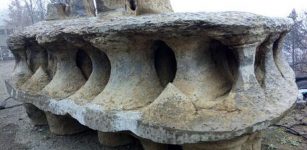 Curious Giant Shaped Rock In China – An Ancient Man-Made Construction Or Natural Formation?
Featured Stories | Jun 26, 2017
Curious Giant Shaped Rock In China – An Ancient Man-Made Construction Or Natural Formation?
Featured Stories | Jun 26, 2017 -
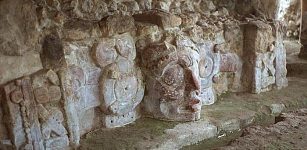 Edzna: Ancient Maya City With Sophisticated Underground System Of Canals To Control Unpredictable Floods
Featured Stories | Jun 2, 2021
Edzna: Ancient Maya City With Sophisticated Underground System Of Canals To Control Unpredictable Floods
Featured Stories | Jun 2, 2021 -
 Cahuachi – Complex Of Truncated Adobe Pyramids In Peru’s Desert
Civilizations | Aug 27, 2015
Cahuachi – Complex Of Truncated Adobe Pyramids In Peru’s Desert
Civilizations | Aug 27, 2015 -
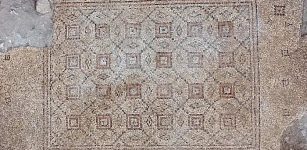 A 1,600-Year-Old Mosaic Accidentally Unearthed In Ancient City Of Yavne, Israel
Archaeology | Apr 26, 2021
A 1,600-Year-Old Mosaic Accidentally Unearthed In Ancient City Of Yavne, Israel
Archaeology | Apr 26, 2021 -
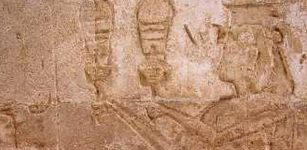 Female Pharaoh Twosret Was Exploited, Used And Almost Erased From History
Featured Stories | Apr 11, 2019
Female Pharaoh Twosret Was Exploited, Used And Almost Erased From History
Featured Stories | Apr 11, 2019 -
 New Archaeological Discoveries In The Temple Of Khnum At Esna, Luxor
Archaeology | Dec 29, 2022
New Archaeological Discoveries In The Temple Of Khnum At Esna, Luxor
Archaeology | Dec 29, 2022 -
 Plutonium: Dangerous Pluto’s Gate Was An Ancient Gateway To Hell At Hierapolis That Was Real
Featured Stories | Feb 18, 2017
Plutonium: Dangerous Pluto’s Gate Was An Ancient Gateway To Hell At Hierapolis That Was Real
Featured Stories | Feb 18, 2017 -
 Ancient Maya Stela Carved On Both Sides Unearthed ‘In Situ’ In Uxmal, Yucatan Peninsula
Archaeology | Oct 31, 2022
Ancient Maya Stela Carved On Both Sides Unearthed ‘In Situ’ In Uxmal, Yucatan Peninsula
Archaeology | Oct 31, 2022 -
 Rare 500-Year-Old Wreck From Missing Ship Samson Discovered In Central Stockholm, Sweden
Archaeology | Dec 20, 2019
Rare 500-Year-Old Wreck From Missing Ship Samson Discovered In Central Stockholm, Sweden
Archaeology | Dec 20, 2019 -
 Bizarre Ancient Capuchin Crypt ‘Decorated’ With The Bones Of 4,000 Monks
Ancient Traditions And Customs | Nov 22, 2018
Bizarre Ancient Capuchin Crypt ‘Decorated’ With The Bones Of 4,000 Monks
Ancient Traditions And Customs | Nov 22, 2018 -
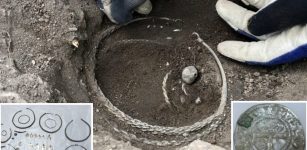 Unique Viking Age Silver Treasure Found On Farm Near Stockholm In Sweden
Archaeology | Nov 12, 2020
Unique Viking Age Silver Treasure Found On Farm Near Stockholm In Sweden
Archaeology | Nov 12, 2020 -
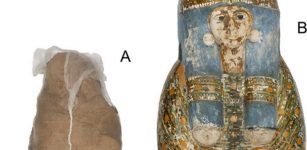 New Study Reveals Rare Mortuary Treatment Of Egyptian Mummy
Archaeology | Feb 8, 2021
New Study Reveals Rare Mortuary Treatment Of Egyptian Mummy
Archaeology | Feb 8, 2021 -
 Neanderthals May Have Been Carnivores – New Study
Archaeology | Oct 17, 2022
Neanderthals May Have Been Carnivores – New Study
Archaeology | Oct 17, 2022 -
 Legendary Brahan Seer Of The Clan Mackenzie (Coinneach) – The Scottish Nostradamus
Featured Stories | Jan 21, 2025
Legendary Brahan Seer Of The Clan Mackenzie (Coinneach) – The Scottish Nostradamus
Featured Stories | Jan 21, 2025 -
 Chinampas: Artificial Islands Created By The Aztecs To Improve Agriculture
Ancient History Facts | May 17, 2016
Chinampas: Artificial Islands Created By The Aztecs To Improve Agriculture
Ancient History Facts | May 17, 2016

